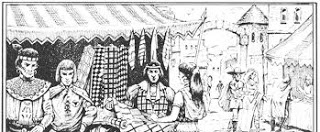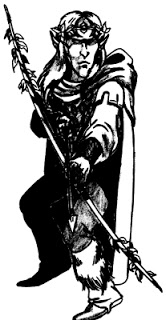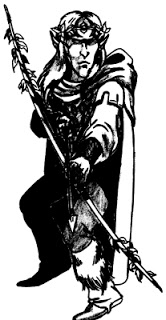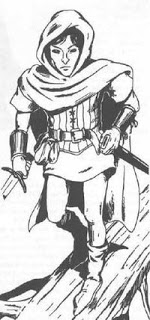DWARF
Dwarves as described in the Player’s Handbook can be found in many regions of the Flanaess. In some cases, dwarven nobles rule over regular states rather than simply hill- or mountain-based enclaves, such as the Principality of Ulek, and either way they are regarded as fully the equal of their human or elven counterparts. Both hill dwarves and mountain dwarves can be found.
ELF
Elves can be found both in secluded communities deep within forested fastnesses as well as major states where they rule over others, including tens of thousands of humans. The elven realms of Celene and the Duchy of Ulek are prominent examples of elven-led realms. Elves of various sorts can be found throughout the woodlands and cities of the Flanaess, and as a rule they get along well with their human and demi-human neighbors, although Celene does maintain a policy of isolationism.
VALLEY ELF
Although the Player’s Handbook lists valley elves under the high elf label, game masters who wish to do so may use the following description instead.
Valley elves are found in only one place on Oerth, known as the Valley of the Mage. Their exact relationship with the Mage of the Valley is unknown, but what is known is that they are implacably loyal to the Mage, and those who venture outside of their Valley are rare indeed. They function as the main core of the army of this strange and reclusive realm, and little is known about their culture. Other elves will shun them, not considering them to be truly elvish, which they consider a fine arrangement, as they have largely eschewed elvish culture as a whole. They are taller than regular elves, some being equal to human height.
Ability Score Increase. Your Intelligence score increases by 1.
Language. You are proficient in gnomish.
Elf Weapon Training. You are proficient with longsword, shortsword, longbow, and shortbow.
WILD ELF (GRUGACH)
Wild elves, as the name implies, dwell in isolated bands, nearly feral, shunning any contact with outsiders, even those of other elvish strains. As a wild elf, you will feel great unease around strangers, and will be completely unfamiliar with civilization and its many social restrictions.
Ability Score Increase. Your Strength score increases by 2.
Elf Weapon Training. You have proficiency with the longsword, shortsword, shortbow, and longbow.
Fleet of Foot. Your base movement rate increases to 35 feet.
Natural Trapper. While in a woodland environment, you can set snares and deadfalls, adding your proficiency bonus to the attempt.
Language Restriction. You do not begin the game fully proficient in the Common tongue; you only speak Elvish. You are at disadvantage when trying to perform any task that involves verbal communication in the Common tongue. You may remove this restriction at any point where you would normally be allowed to increase an ability score or take a Feat.
HALFLING
Halflings exist throughout the Flanaess, but are largely content to remain in their quiet agricultural communities alongside their human and demi-human compatriots. There are no halfling realms in the Flanaess, although they do make up a large portion of the military auxiliaries in a number of human states’ armies, often functioning as scouts or slingers. There are three types of halfling found in the Flanaess; Hairfoots (labeled Lightfoots in the Player’s Handbook), Tallfellows, and Stouts (as described in the Player’s Handbook).
TALLFELLOW
As a tallfellow halfling, you are rumored to have a trace of elvish blood in your veins, on your great-grandmother Willow’s side of the family, which is rarely talked about in polite company over Elevenses. You’re taller than the average halfling, and can ride a pony without difficulty. Your kind are most often found in elvish realms and near elvish communities, for obvious reasons.
Ability Score Increase. Your Strength score increases by 1.
Languages. You can speak, read, and write elvish as well as halfling and the Common tongue.
It’s as tall as I am. You have proficiency with spear.
Naturally stealthy. Just like a hairfoot halfling, you can attempt to hide even when you are obscured only by a creature that is as at least one size larger than you.
HUMAN
 There are four major human strains to be found in the Flanaess. The Baklunish, Flan, Oeridian, and Suel races, and their various admixtures, form the overwhelming majority of humanity in the western portion of Oerik. The Rhennee are concentrated in the central Flanaess around the lands of the Nyr Dyv, while the Olman and Touv peoples are rare in the extreme and hail from exotic lands far to the south.
There are four major human strains to be found in the Flanaess. The Baklunish, Flan, Oeridian, and Suel races, and their various admixtures, form the overwhelming majority of humanity in the western portion of Oerik. The Rhennee are concentrated in the central Flanaess around the lands of the Nyr Dyv, while the Olman and Touv peoples are rare in the extreme and hail from exotic lands far to the south.
Few lands in the modern Flanaess have pure-blooded majorities of any human racial stock. Characters hailing from one of the nations listed below may choose from any of the major strains found there; minor strains are listed solely for aesthetic reasons; someone of Oeridian stock from Nyrond, for instance, could well have the trademark platinum blond hair from some distant Suel ancestor, although he would still reckon himself as being of Oeridian stock. The order of the strains listed indicates the relative strength of their representation, but for game purposes such subtleties have no impact on the choice of human sub-race by a player.
.tg {border-collapse:collapse;border-spacing:0;}
.tg td{padding:10px 5px;border-style:solid;border-width:1px;overflow:hidden;word-break:normal;}
.tg th{font-weight:normal;padding:10px ;border-style:solid;border-width:1px;overflow:hidden;word-break:normal;}
.tg .tg-yw4l{vertical-align:top}
| Nation |
Major Strains |
Minor Strains |
|---|---|---|
| Almor | Oeridian, Suel | n/a |
| Amedio Jungle | Olman | n/a |
| Bandit Kingdoms | Oeridian, Flan, Suel | Baklunish |
| Barbarians, Frost, Ice, or Snow | Suel | n/a |
| Bissel | Oeridian, Suel, Baklunish | n/a |
| Blackmoor | Baklunish, Oeridian | n/a |
| Bone March | Oeridian, Suel | n/a |
| Celene | Suel | n/a |
| Dyvers | Oeridian, Suel | Flan, Baklunish |
| Ekbir | Baklunish | n/a |
| Geoff | Flan | Oeridian |
| Gran March | Suel, Oeridian | Flan |
| Great Kingdom | Oeridian, Suel | n/a |
| Greyhawk | Oeridian, Suel | Flan, Baklunish |
| Highfolk | Oeridian | Suel |
| Idee | Oeridian, Suel | n/a |
| Irongate | Oeridian | Suel |
| Iuz | Oeridian, Baklunish | Flan |
| Keoland | Suel, Oeridian | Flan |
| Ket | Baklunish, Oeridian, Suel | n/a |
| Lordship of the Isles | Suel | Oeridian |
| Medegia | Oeridian | n/a |
| Nyrond | Oeridian | Suel |
| Olman Islands | Olman | n/a |
| Onnwal | Oeridian | n/a |
| Pale | Flan, Oeridian | n/a |
| Paynims | Baklunish | Oeridian |
| Perrenland | Oeridian | n/a |
| Pomarj | Oeridian, Suel | n/a |
| Ratik | Suel | Oeridian, Flan |
| Rel Astra | Oeridian | Suel |
| Rovers of the Barrens | Baklunish, Flan | n/a |
| Scarlet Brotherhood | Suel | n/a |
| Sea Barons | Suel | Oeridian |
| Sea Princes | Suel, Oeridian | Flan |
| Shield Lands | Oeridian | n/a |
| South Province / Ahlissa | Oeridian | Suel |
| Spindrift Isles | Suel | Oeridian |
| Sterich | Oeridian, Flan, Suel | n/a |
| Stonefist | Flan, Suel | n/a |
| Sunndi | Oeridian | Suel |
| Tenh | Flan | n/a |
| Tiger Nomads | Baklunish | n/a |
| Tusmit | Baklunish | Oeridian |
| Ulek, County of | Oeridian, Flan, Suel | n/a |
| Ulek, Duchy of | Suel | Flan, Oeridian |
| Ulek, Principality of | Oeridian-Suel | n/a |
| Ull | Baklunish | n/a |
| Urnst, County | Suel, Oeridian | n/a |
| Urnst, Duchy | Suel | n/a |
| Valley of the Mage | Oeridian, Baklunish | Flan |
| Veluna | Oeridian | Suel, Flan |
| Verbobonc | Oeridian | Flan, Suel |
| Wild Coast | Suel | Oeridian, Flan |
| Wolf Nomads | Baklunish, Flan | n/a |
| Yeomanry | Suel, Oeridian | Flan |
| Zeif | Baklunish | n/a |
BAKLUNISH
Baklunish folk have skin with a golden hue, and grey, green, or hazel eyes. They have dark hair and tend towards hirsuteness. Those in the north tend towards brightly colored clothing, often with patterns dazzling to the eye. They wear either robes or short pants with long coats. Those in the south favor pastel parti-colored clothing, with complex stripes, puffs, and slashes.
FLAN
Flannae are generally bronze-hued, ranging from lighter copper to near brown. They have dark eyes, but occasionally an amber-eyed Flan will be found. Hair is dark, ranging from black to dark brown, and tends to be either wavy or curly. Their dress tends to be modest and of solid and bright primary colors.
OERIDIAN
Oeridians are dark-skinned, ranging from tan to olive, and have hair color from dark blond to black, but various shades of brown predominate. They can have eyes of just about any color, but grey and brown are most common. Those in the far east tend to wear plaids, with the pattern denoting their clan, while those in the west tend towards checks (although variations from the standard square pattern are most common). Clothing tends to be close-fitting.
OLMAN
Representatives of the Olman people are relatively unknown in the Flanaess in CY 576, but after the Scarlet Brotherhood brought many thousands of them into the lands around the Azure Sea as troops and slaves in CY 585, they become a more common sight. Their skin is a red-brown and their hair is straight and black, and they have dark eyes. It is not unknown for Olman parents to flatten the skulls of their infants, as a high, sloping forehead is highly prized among them. Their clothing tends to the simple, but is dazzlingly decorated with beads, feathers, and the like. Leaders will have elaborate headdresses.
RHENNEE
The Rhennee are strangers to Oerth, or so their legends say. Inveterate wanderers, they are mostly found as bargefolk in and around the Nyr Dyv, but a branch known as the Attloi undertakes their journeys in wagons rather than on the water. They have skin of olive to tan color, much like Oeridians, and dark curly hair. They tend to be shorter than normal, and have a well-deserved reputation as thieves, con men, and rogues. Only women are ever encountered as spellcasters, and then never as clerics; if the Rhennee have any gods in which they believe, they do not rely on them for magical abilities. Their dress tends to the functional and eschews bright colors, but the quality of their leatherwork is noteworthy.
Rhennee speak their own language as well as whatever other languages they may happen to speak. They use their language as a sign of recognition among the True Folk, as they call themselves.
Rhennee can be found mostly around the Nyr Dyv and its connecting rivers. Rhennee barges can be found as far upstream as Verbobonc, Molag, Stoink, Trigol, Nellix, and Hardby. Atloi wagon caravans can be found in roughly the same region, although they obviously don’t need to remain close to the water.
SUEL
The Suel people are fair-skinned to the point of near-albinism, and their hair color runs from platinum blond to red. Their eyes are some shade of blue or violet, but occasionally grey. They wear solid colors, often wearing two (or occasionally three) colors to denote their house, and tends to be of loose cut.
UNCOMMON RACES
DRAGONBORN
Dragonborn are native only to Dragons Island, far to the southwest of the Flanaess. They are rare enough in the Celestial Imperium, which is the closest civilized land to the island; dragonborn who have ventured as far as the Flanaess are exceedingly rare and will certainly be objects of curiosity and/or hostility, often being mistaken for cambions (half-demons).
GNOME
Gnomes are relatively common in the Flanaess. Some gnomish communities, such as those found in disputed border territories, are independent enclaves, while others are fully integrated into larger realms and make up a significant portion of the population, such as the County of Ulek. Sometimes gnomish contingents will make up large portions of regular armies. However, all gnomes encountered in the Flanaess will be of the forest gnome type. Rock gnomes, as described in the Player’s Handbook with their tinkering and inventive ways, are unknown in the Flanaess.
HALF-ELF
Half-elves are relatively common in the Flanaess, owing to the relatively high degree of contact between the elven and human communities.
HALF-DROW
The drow of Oerth are both fecund and degenerate, and are not above mating with human slaves (or non-slaves) from time to time. The result of such unions are universally despised by both the drow and human communities, and while they are not uncommon in drow communities, they are exceedingly rare on the surface. Half-drow do not have the magical or training benefits of full-blooded drow.
Ability Score Increase. Your Constitution score increases by 1.
Darkvision. Your darkvision has a radius of 60 feet.
Sunlight Sensitivity. You have the same weakness in sunlight as a full-blooded drow.
TIEFLING
Tieflings are very rare in the Flanaess, and any tieflings found in a Greyhawk campaign will be regarded by nearly everyone they encounter as cambions (half-demons) at best, or more likely some sort of creature from the lower planes. They will suffer even more prejudice because of their appearance in most civilized places, with the possible exception of lands such as Iuz and the Great Kingdom, where cambions are relatively common. In such an environment, a tiefling might be less of a novelty, but would still find life difficult at best; certainly more difficult than they would in a world where they were at least native. In campaigns set after CY586, when the Flight of the Fiends caused most of the demons and other creatures from the lower planes to flee the material plane, tieflings will still be confused for demons or semi-demons, but will stand out all the more because of it, and face more suspicion and hostility.












I've started a Ratikkan campaign and I did a D6 for human origin.
1. Flan -Very Pict like
2. Suel (1 in 6 is an albino) outsider/Northlander barbarian type
3. Oeridian -Nyrond
4. Oeridian -Great Kingdom/Bone March refugee
5. Oeridian -Ratikkan
6. Baklunish -worry about it if I get there.
My two copper pieces anyway.
The variant human build serves Greyhawk well: bonus feat and bonus skill. There's lots of room to play and expand on human Cultural Diversity of Oerik. In my own game I grant humans one extra language and one proficiency. It doesn't add power to humans. Instead, we get to roleplay human cultures. Enclaves of humans that don't speak Common and tribes of humans that all ride horses or travels in caravans. Adding a human only language opens a narrow door. Adding a language as part of being human shouldn't be a role-playing tax. For Greyhawk, human is a background. To be a Suel Charlatan is very different from an Oerdian Charlatan. It helps us explore the world.